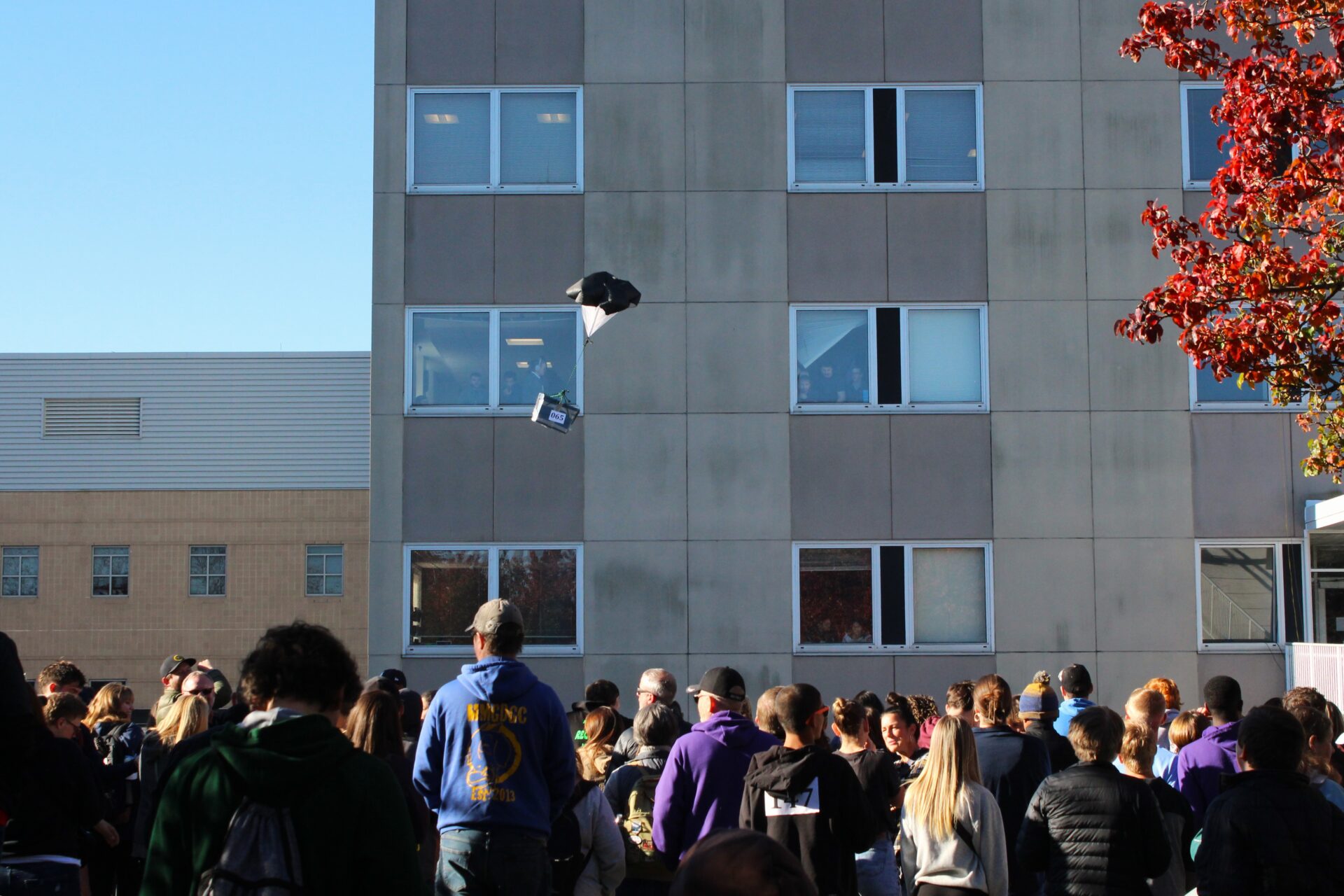Pumpkins are an iconic image of Halloween and fall. An annual event at West Virginia University turns them into a learning experience students won’t soon forget.
More than 1,000 students from across West Virginia and western Pennsylvania tried to keep their gourds intact this past Friday, Oct. 25, as they sailed more than 100 feet through the air at the 35th annual Pumpkin Drop at West Virginia University. On the line are cash prizes: $100 for first, $50 for second and $25 third place as well as bragging rights for the best protected pumpkin.
Students like eighth grader Luke Moore from Tyler Consolidated Middle School form teams with classmates to try and create a structure that will protect their pumpkin from the drop. Moore said his team tried an unconventional shape to absorb the force of an 11-story fall off the WVU Engineering Sciences Building.
“We built an upside down pyramid so it can go down easier,” Moore said “And if it hits the tip, the energy is dispersed through the top of the pyramid.”
Ultimately the design wasn’t successful, although another team of Moore’s classmates did tie for third this year. While a smashed pumpkin isn’t great, Moore and his teammates are in good spirits.
”The people here are really great,” he said. “And the fact that we get to do a school project and then come to a school like this and get to throw stuff off the building.”
Teachers and students alike are energized by the event. Melissa Courtright, a seventh and eighth grade gifted teacher at Mountaineer Middle School in Morgantown, said the event promotes a lot of engineering design and creativity from students. They must adhere to certain rules like using a pumpkin with a diameter of at least 10 inches, and a total structure weight of no more than 50 pounds to protect it during the freefall.
Chris Schulz/West Virginia Public Broadcasting
“Our kids have spent the last week or so developing and building enclosures for their pumpkins to protect them from this huge drop, from the roof to the ground, and trying to get them as aerodynamic as possible, so that they can also land within this target,” Courtright said.
She said the event is a great and unique educational opportunity, both before and after.
“We just love doing the event. And we even like the after, where we do a full, deep debrief with our kids. They have to know, did their pumpkin survive? How far was it from the target? Like, what could they have changed? And so they learn from the experience, and that’s what we hope that they get out of it, is that learning experience.”
Scott Wayne, an associate engineering professor at WVU, was a student at the university when the drop started in the 1980s.
“When we first started, it was a fun competition for engineering students,” he said. “Our freshman engineering students got involved, and then we started inviting the middle school and high school kids, and they’ve really kept it going.”
He is now the faculty advisor of the American Society of Mechanical Engineers student chapter which sponsors the pumpkin drop. Wayne sees in the pumpkin drop not only an opportunity to learn about physics, science and math, but also for younger students to start thinking about their academic futures.
“It allows them to come to WVU campus and to see the campus and hopefully start them thinking about college careers in the science, math and engineering fields,” he said.
Wayne points out that the event serves two good purposes.
“All of the entry fee proceeds go to support families whose children are being treated here at Ruby Memorial Hospital or Mon General Hospital, and it’s just a great educational learning opportunity for these students.”
Jennifer Shephard/WVU Photo
Adrienne Titus is a parent of students at Covenant Christian School in Morgantown, one of whose teams tied for third with Tyler Consolidated. She said part of the appeal of the pumpkin drop event is bringing so many different schools and students together.
“It’s great for the kids to be able to come together from all different areas and cheer each other on. It just brings a sense of unity to all the schools, I think, which is really good,” Titus said.
According to Titus, students learn more than math and engineering in the process of protecting their pumpkins. Almost all drop contestants submit a collaborative build with at least one other student, requiring collaboration on design, material choice and the actual assembly.
“It’s just getting them to work together as a team, which I think is the best thing, because everyone’s got different ideas, and they have to come together and agree on one,” she said.
The importance of teamwork is a lesson the students themselves are quick to see the value in.
“Be wise of the people who you choose partners with,” Moore said.
Now, pumpkins on neighbors’ stoops and steps will be a reminder for students of their hard-earned physics lessons. And perhaps inspiration for next year’s drop.
